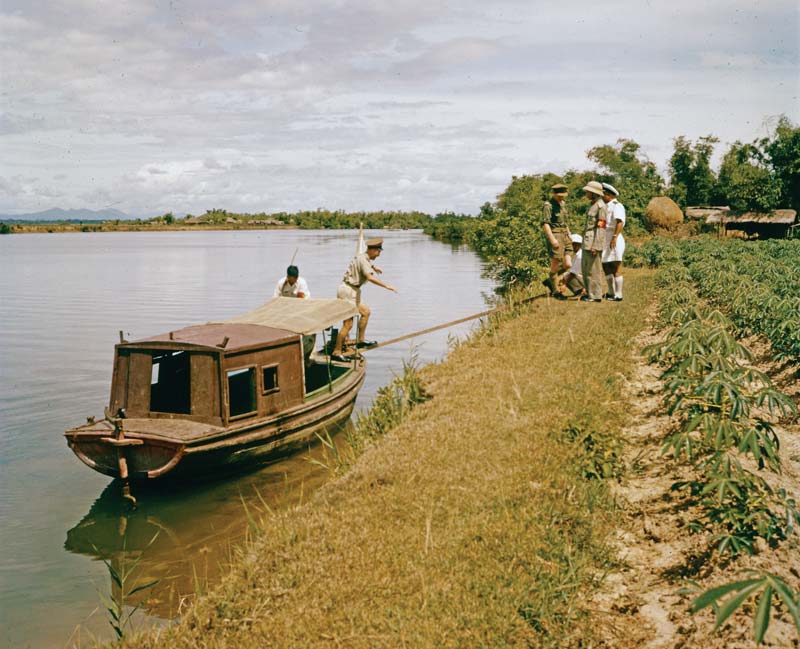
Unidentified military members of the Canadian delegation to the international control commission in South Vietnam. [LAC/4234538]
In the last half of the 19th century, France gradually established control over the southeast Asian monarchies of Vietnam, Cambodia and Laos, an area collectively known as French Indochina. The French attempted to preserve the traditional way of life, while exploiting the colony’s resources.
During the Second World War, Japan allowed the Vichy French to administer Indochina. Japanese forces stationed 30,000 soldiers there and used Vietnamese ports for their other operations throughout southeast Asia.
By the time Japan surrendered at the end of the war, the communist Viet Minh under Ho Chi Minh had emerged as the leading representatives of Vietnamese nationalist ambitions. Without opposition, the Viet Minh seized power.
With the initial assistance of Britian, France began to re-occupy its former colony, but was unsuccessful in the face of local resistance movements. Two Vietnams emerged: a communist north and a non-communist south.
Irreconcilable differences between the French and the Viet Minh—the former wanted to re-establish colonial rule, while the latter wanted complete independence—led to a protracted guerilla war in late 1946. In 1949, with the assistance of the new Communist government in China, the Viet Minh were ultimately successful.
Between April and July 1954, the Geneva Accords were negotiated, which resulted in a ceasefire and the temporary division of Vietnam into two separate entities at the 17th parallel, along a demilitarized zone.

Vietnamese refugees board a ship in October 1954.[U.S. Navy/Wikimedia]
The conference that produced the accords was attended by representatives of the United States, United Kingdom, France, the Soviet Union and China, plus Cambodia, Laos and both Vietnams. The French, Vietnamese, Cambodian and Laotian representatives signed the agreement, but none of its provisions were binding. Canada had three observers at the conference, led by secretary of state for external affairs and future prime minister, Lester B. Pearson.
The Geneva Accords also established the International Commission for Supervision and Control. The ICSC was to monitor the exchange and withdrawal of military forces, equipment and supplies, as well as to supervise the transfer of power from the French to the governments of North and South Vietnam.
The commission was also to ensure that no new military equipment entered Vietnam, except as replacements for equipment that had been destroyed, and that no new military facilities were constructed. Another task was to oversee the return of displaced persons and refugees within a limited period. Any violations of the agreement were to be reported to the ICSC, which would then send teams to investigate.
The final declaration of the Geneva Accords called for the commission to supervise elections. These were to be held throughout Vietnam in July 1956 to unify the nation.
Three countries were asked to supervise the ceasefire agreement: Belgium, Poland and India, representing respectively the non-communist, communist and non-aligned blocs. But Belgium, as a former colonial power, was unacceptable to the Chinese and Vietnamese, so Canada was asked instead. India provided the chair and most of the logistical and command and control support for the ICSC.
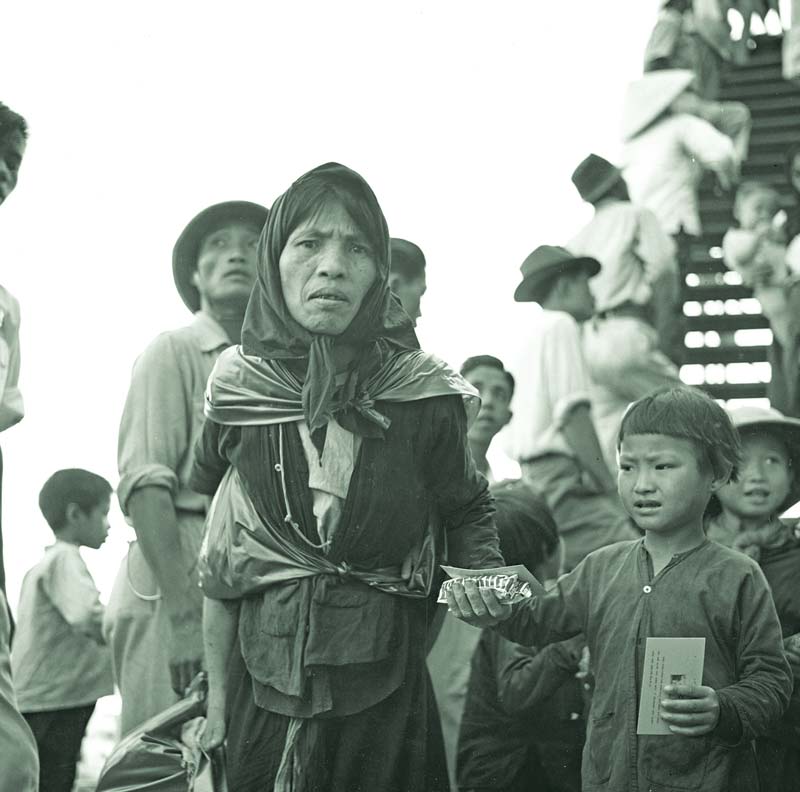
Vietnamese refugees disembark a ship in Saigon in May 1955. [Herb Taylor/NFB/LAC4297806]
It was an unenviable task for Canada that was doomed from the start, given the opposing ideologies not only of North and South Vietnam, but also of the member nations of the ICSC. The involvement of so many stakeholders in the preparation of the accords resulted in much of their content being confusing, contradictory and ambiguous. Despite the foreshadowing of failure, most Canadian diplomats believed the country had no choice but to serve when asked.
The Canadian ICSC members came largely from the army. Besides inspectors, the army provided clerks and signallers, as well as medical and security personnel. Initially, 150 Canadians deployed to Vietnam in August 1954, 135 of them from the military.
John Holmes, the external affairs officer responsible for Indochina, credited the army for the accomplishments of the initial deployment: “[The Canadian Army] rounded up on short notice the best staff-trained officers who could be taken away from their present duties and fielded within a few weeks teams for Vietnam, Cambodia, and Laos which carried on their unaccustomed duties of soldier, diplomat, and judge with remarkable success.”
The Royal Canadian Air Force supplied three officers who, besides providing technical advice, inspected airfields to confirm they were not being used for military purposes. They could also scrutinize aircraft unloading cargo, although the Vietnamese on both sides usually obstructed any attempts to carry out such tasks.
The Royal Canadian Navy, meanwhile, provided three officers as advisors and to inspect facilities. Both the north and south supplied boats to the naval officers to patrol the coastline, but they rarely saw anything because the Vietnamese carried out any illegal operations in areas where inspectors were not visiting.
The ICSC established its headquarters in Hanoi in North Vietnam along with 14 teams—seven in the south and seven in the north. Each six-man team had two members from each contributing country. Teams were stationed at air, rail and sea entry points and assigned areas in which to operate.
An undetermined number of mobile teams were also allowed—each with one member from a commission nation—which were to have complete freedom of movement across the border and in the demilitarized zone. These teams were to patrol areas between the fixed teams, but were never permitted to operate as planned.
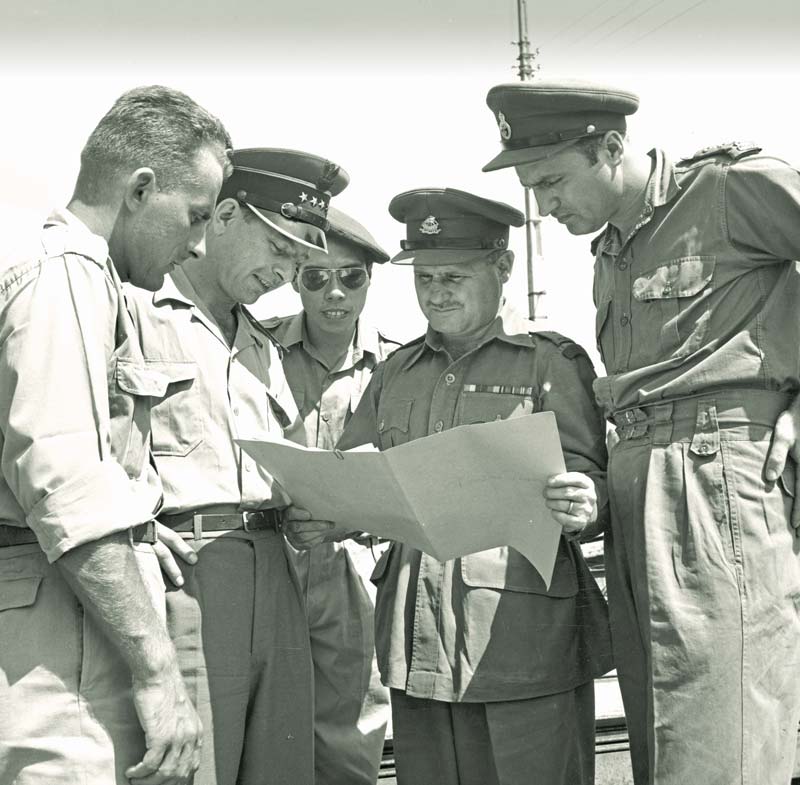
Members of the control commission check a cargo manifest. [Herb Taylor/NFB/LAC/4297805]
The commission’s most significant drawback was that it had no executive power. Reports from teams were passed to ICSC headquarters, which could do little more than record them and send them on to the accords’ co-sponsors, Britain and the Soviet Union, then to a joint commission composed of France and North Vietnam.
Despite this challenge, the ICSC did accomplish some of its assigned tasks. In its first year, it had successfully supervised the transfer of power from France to new regimes in North and South Vietnam, as well as the withdrawal of French forces from the area.
According to philosopher Charles Taylor, normally a critic of Canada’s involvement in the commission, this “was an achievement in which Canadian diplomats and soldiers rightly took enormous pride.”
The task of overseeing the return of refugees and displaced persons remained a continuing problem throughout the ICSC’s existence, while the job of preventing new military equipment and personnel from entering the new countries failed entirely.
Probably the most difficult issue was that of holding free and fair elections by 1956. Canada and other western countries realized that the Communists would likely win an election and unite the country under a socialist regime.
With anti-communist feelings running high at the time, the West did not want such a system imposed on South Vietnam. The south postponed the elections, a decision quietly approved by the West.
Canada’s involvement in the commission “was an achievement in which Canadian diplomats and soldiers rightly took enormous pride.”
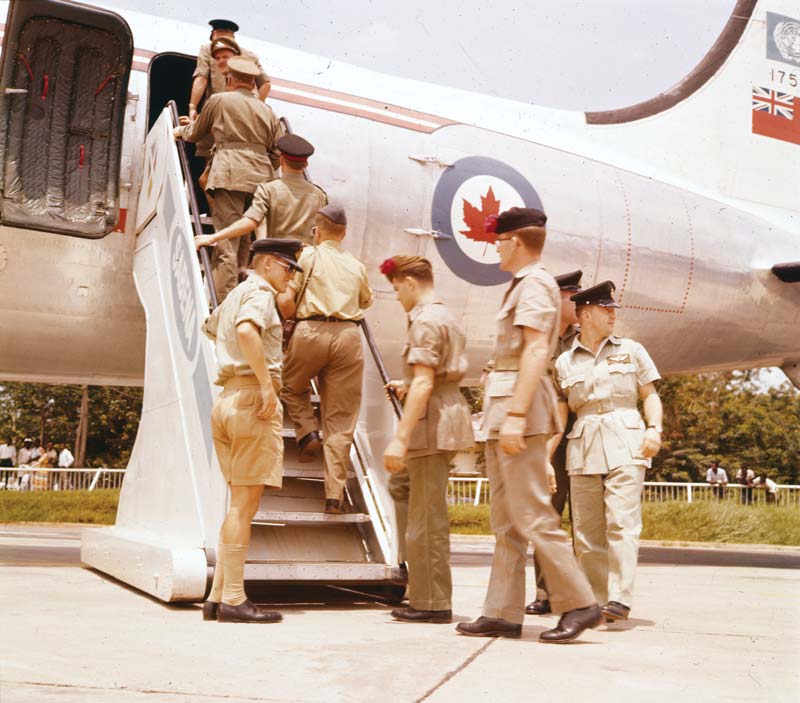
Canadian military members of the commission board a flight in South Vietnam. [LAC/4234549]
Both countries arranging the teams’ visit locations and dates so that they never found anything in violation of the accords also hindered the commission’s effectiveness. Additionally, the teams’ visits required agreement among their members, a unanimity that was only occasionally achieved.
In fact, the terms of the Geneva Accords had doomed the commission from the start. Without a signed agreement, the ICSC lacked the authority to supervise or control most situations. This resulted in both the north and the south importing weapons through ports and airfields to which they denied the commission temporary access.
Plus, none of the ICSC members were completely neutral in carrying out their mandate. “The Canadians pressed, the Poles obstructed, and the Indians dithered,” concluded historian Robert Bothwell.
Once France had completed its withdrawal from Indochina, however, it left the joint commission with North Vietnam as its only member. At that point, South Vietnam refused to be bound by the accords and the ICSC became ineffective.
As a result, North Vietnam began to send communist agents into the south, where they were to generate support for the north and encourage revolution from within. Open warfare followed in 1965, the same year that the U.S. began to send active combat units to help South Vietnam, where previously it had only provided advisers.
In March, the north forced commission headquarters out of Hanoi (it relocated to Saigon), along with the seven fixed teams stationed in the country. The rationale used by the North Vietnamese was they could no longer protect ICSC members from American attacks.
External affairs policy-makers continued to hope that the ICSC’s presence might lead to a resolution of the war.

Some 12,000 Canadians served in combat roles with U.S. forces during the Vietnam War, including Ron Payne, Richard Dextraze and Arthur Fisher. The International Commission for Supervision and Control Indo-China Medal was awarded to Canadians with 90 days of cumulative service with the unit. [CBC; CWM/19770265-007]
Canada remained a member of the commission despite its ineffectiveness and the presence of U.S. combat forces in large numbers. Bothwell described the commission’s operation during this period as “a routine of trips North, trips South, trips out, reports, and debate.”
Despite the frustration of Canadian inspectors on the ground, external affairs policy-makers continued to live in hope that the ICSC’s presence might somehow lead to a resolution of the war. From 1960, however, Canada reduced its numbers slowly, leaving only 20 by the start of 1970. The mission ended in January 1973.
That same month, the U.S. asked Canada to be a member of a new commission to monitor the ceasefire signed at the Paris Peace Conference, which ended the Vietnam War. Canada agreed, providing it could withdraw if the group was not effective. Besides Canada, the similarly named International Commission for Control and Supervision had three other members: Poland, Indonesia and Hungary.

A U.S. Vietnam War propaganda poster. [Jack Thurston/CWM/19890208-001]
The ICCS totalled 1,160 personnel. Canada provided 240 armed forces members and 50 diplomats to the new organization, which arranged for the release and transfer of more than 32,000 prisoners of war, including 500 Americans. One of them was U.S. Navy Lieutenant-Commander John McCain, who had been held for five and a half years and later became a senator and presidential candidate.
Due to its ineffectiveness, Canada unilaterally withdrew from the ICCS in July 1973; a first in the country’s peacekeeping history. Iran took Canada’s place and the commission operated until April 1975.
One of Canada’s earliest forays into peacekeeping had not been as effective as hoped.
Canadians in combat in Vietnam
Estimates vary, but somewhere between 20,000 and 40,000 Canadians enlisted in the U.S. forces during the Vietnam War, with approximately 12,000 serving in combat roles. At least 134 died or were declared missing in action.
Twenty-one-year-old U.S. Marine Corps Lance Corporal Richard Dextraze was one of those killed. He was the youngest son of then Major-General Jacques Dextraze, later Canada’s defence chief and known to all as “Jadex.”
Richard Dextraze, a reconnaissance scout, was awarded a posthumous Silver Star Medal for his bravery. On April 23, 1969, although already wounded in the face, he continued to deliver suppressive fire onto an enemy machine-gun post when he was mortally wounded. He is buried beside his father in Montreal’s Notre-Dame-
des-Neiges Cemetery.
Toronto-born Peter Lemon, meanwhile, received the highest American military award—the Medal of Honor. On April 1, 1970, the 19-year-old assistant machine gunner fought off a heavy enemy attack with a combination of machine-gun and rifle fire, grenades and hand-to-hand combat and was wounded three times during the battle.
Canadian casualties on the Vietnam commissions
Five Canadians died while serving on the international Vietnam commissions. On Oct. 18, 1965, Sergeant James Byrne, Royal Canadian Army Service Corps, and Corporal Vernon Perkin, The Black Watch (Royal Highland Regiment) of Canada, were killed in an airplane crash, along with Canadian diplomat John Turner. Their bodies were never recovered. On May 8, 1970, army clerk Philip MacDonald died in Saigon.
On April 7, 1973, International Commission for Control and Supervision member Captain Charles Laviolette, 12e Régiment blindé du Canada, and eight other commission members died when their helicopter was shot down over Viet Cong territory.
In addition, on June 28, captains Ian Patten of The Royal Canadian Regiment and Fletcher Thomson, an RCAF engineer, were detained, interrogated as “spies” and held by the Viet Cong for 18 days. When released, Thomson noted he “weighed twenty-five pounds less.”
In a bizarre twist of fate, on April 1, 1975, Patten was killed by an allegedly stray bullet as he stood on the balcony of his room in the Ledra Palace Hotel in Nicosia. He was serving on his third peacekeeping tour in Cyprus.
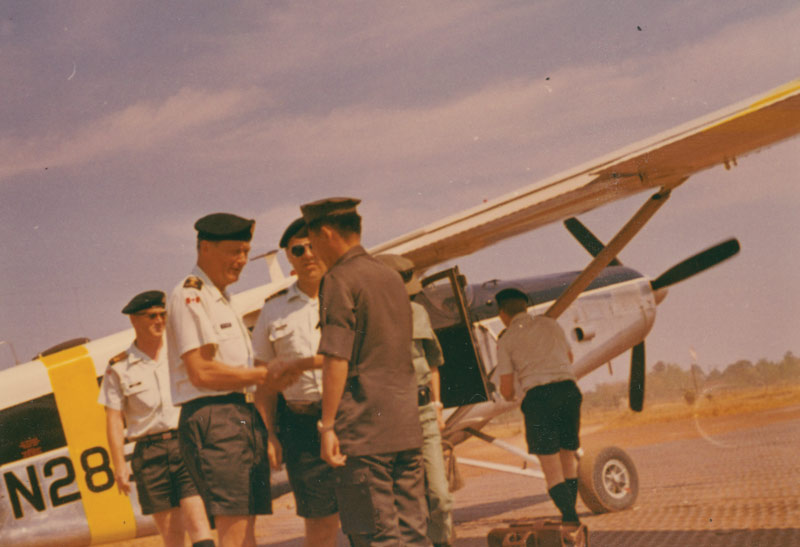
Canadian members of the commission board a flight in South Vietnam in January 1973 as their mission ends.[Major Richard Malott/CWM/19830634-031]
Advertisement


















